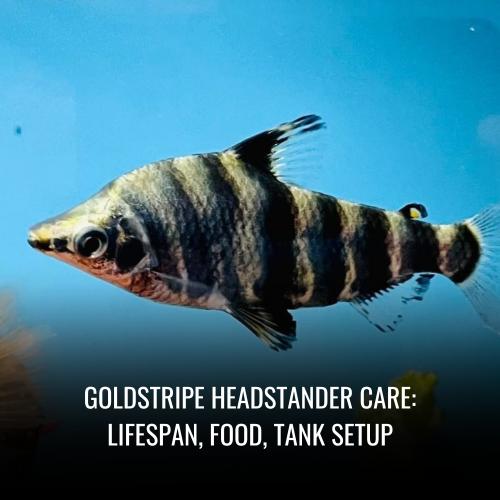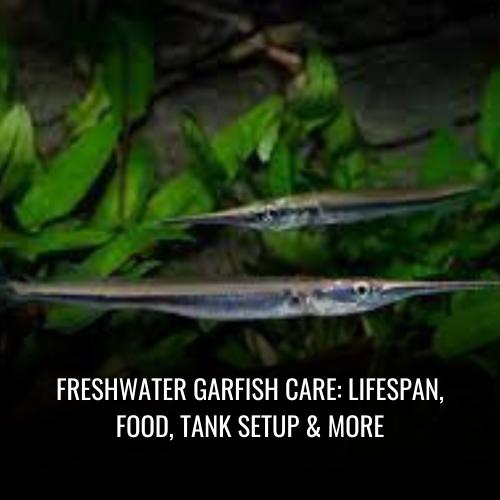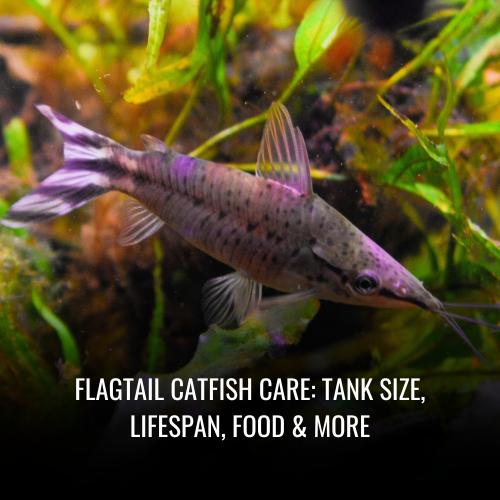The Peppered Corydoras, scientifically known as Corydoras Paleatus, is a cherished Freshwater fish renowned for its peaceful demeanor and striking patterning, resembling a peppered effect. Originating from the streams and rivers of South America, these hardy fish have become a staple in the aquarium trade, favored by both novice and experienced aquarists for their adaptability and low-maintenance nature.
Accommodating Peppered Corydoras requires attention to their environment, avoiding sharp substrates that could harm their sensitive barbels. They appreciate a variety of foods, such as brine shrimp, white worms, and plant matter—all of which ensure a balanced diet.
Below is an informative table that outlines the specific requirements and characteristics of Peppered Corydoras:
| Attribute | Information |
|---|---|
| Scientific Name | Corydoras Paleatus |
| Common Name | Peppered Corydoras |
| Family | Callichthyidae |
| Usual Size in Fish Tanks | Up to 6cm (2.4 inches) |
| Recommended pH Range | 6.0 – 7.0 |
| Recommended Water Hardness | 2 – 30 dGH |
| Recommended Temperature | 22 – 26°C (72 – 79°F) |
| Reproduction | Egg scatterer |
| Origin | South America |
| Temperament to Own Species | Peaceful |
| Temperament to Other Fish | Peaceful |
| Usual Place in the Tank | Bottom Dweller |
| Lifespan | Up to 5 Years |
| Tank Size Requirement | 20+ Gallons (for small groups) |
| Filtration System | Moderate – Good, with gentle flow |
| Sexual Dimorphism | Females larger and rounder |
| Substrate Cleaning | Yes |
Companions for Peppered Corydoras could include dwarf cichlids and other peaceful fish species that are not aggressive, ensuring a serene aquatic environment. Providing fish food that is formulated for bottom feeders will ensure proper nutrition, contributing to their well-being as a peaceful community fish.
Scientific Name
This unique fish was first discovered in the 1830s within the expansive Ro de la Plata Basin. Memorializing this discovery, the species was formally named Corydoras paleatus. These remarkable fish made further history when they became one of the first species to be bred in captivity specifically for the aquarium trade. A significant milestone was marked in 1878 when the first successful breeding occurred in Paris, France, solidifying their place in aquarist communities worldwide.
| Scientific Element | Description |
|---|---|
| Cory | Greek for ‘helmet’ |
| Doras | Greek for ‘skin’, implying armored protection |
| Paleatus | Latin for ‘chaff’, describing the fish’s patterning |
| First Bred | 1878, in Paris, France |
| Habitat Origin | Ro de la Plata Basin, discovered in the 1830s |
The integration of Greek and Latin in the etymology of Corydoras paleatus reflects the fish’s characteristics and history, from physical attributes to milestones in aquaculture.
Average Size
The Peppered Corydoras, known among enthusiasts as an endearing and compact member of the armored catfish family, reaches an average adult length of just 2.5 inches or 6.3 cm. Ideal for aquarists with spatial limitations, these diminutive fish can comfortably inhabit smaller fish tanks. Juvenile Peppered Corys are particularly tiny when brought home, measuring a mere 0.5 to 1 inch (1.3 to 2.5 cm), which underscores the need for gentle acclimation to their new aquatic surroundings.
A minimum tank size of 10 gallons is recommended to provide these peaceful schooling fish the space they need. In such an environment, a group of six or more Peppered Corydoras can exhibit natural behaviors and dynamics comfortably. Captive breeding has introduced variations in the species, with tank-raised individuals typically displaying less vivid patterning and brightness compared to their wild counterparts, despite sharing similar dimensions. Notwithstanding their slight stature, Peppered Corydoras are known for their resilience and adaptability, attributes that have earned them the status of a favored species, especially for those new to fishkeeping.
| Size | Source | Tank Size Recommended |
|---|---|---|
| 0.5-1 inch | Juvenile | At least 10 gallons |
| 2.5 inches | Adult | At least 10 gallons |
Their manageable size paired with a hardy nature makes Peppered Corydoras an excellent choice for both novice and experienced aquarists alike.
Lifespan
The Peppered Corydoras, also known as Corydoras paleatus, is not only a delightful and peaceful community fish but also a notably hardy species, capable of gracing a well-maintained aquarium for many years. When provided with optimal care, including a diet of high-quality fish food like brine shrimp and frozen foods, they showcase impressive longevity.
In general, aquarists can expect their Peppered Cory to thrive for a typical lifespan of around 10 years. However, under exemplary conditions, where attention is paid to their preferences for plant matter and avoidance of sharp substrates that could harm their sensitive barbels, these fish have been known to surpass the average, reaching up to 15 years of age.
It’s rare for these Peppered Corys to succumb shortly after introduction to a tank. Should this happen, it’s likely due to the stress of shipping or a significant shift in water parameters, rather than a shortcoming in the species’ robustness. Indeed, they are recognized for their hardiness and, given an environment close to their native South American habitats, can enjoy a lengthy lifespan.
| Ideal Lifespan | Conditions |
|---|---|
| 10 to 15 years | With proper care & conditions |
| 5+ years | Under ideal conditions |
Peppered Corydoras represent the epitome of peaceful schooling fish and, when kept in groups within a spacious fish tank, can be a long-lived addition to any aquarium setting.
Natural Habitat
The Peppered Corydoras, natives of the sprawling Río de la Plata Basin in South America, grace a variety of aquatic environments. These resilient fish dwell in countries like Argentina, Brazil, Paraguay, Suriname, and Uruguay, navigating through diverse habitats that range from murky rivers and bustling streams to tranquil small lakes. Discovered in the 1830s by the famed Charles Darwin during his seminal voyage on the HMS Beagle, Peppered Corys exhibit remarkable adaptability to various substrates, including mud, sand, and rock.
One of their most fascinating traits is their ability to supplement oxygen intake. Unlike many freshwater fish, Peppered Corys occasionally venture to the water’s surface, taking quick breaths of atmospheric air before returning to their bottom-dwelling explorations. This behavior is a testament to their unique respiratory adaptation, allowing them to thrive in habitats where oxygen levels might fluctuate.
| Country | Natural Habitat Types |
|---|---|
| Argentina | Rivers, streams, small lakes |
| Brazil | Rivers, streams, small lakes |
| Paraguay | Rivers, streams, small lakes |
| Suriname | Rivers, streams, small lakes |
| Uruguay | Rivers, streams, small lakes |
- Substrates: Mud, Sand, Rock
- Remarkable trait: Surfaces for air intake
These aspects of their natural South American habitats give us insights into the care requirements of Peppered Corydoras within the aquarium trade.
Appearance
In the fish tank, Peppered Corydoras, also known as Corydoras paleatus, captivate onlookers with their ornate coloration and dynamic movements. These peaceful fish showcase a speckled pattern of black spots and patches over a silver-grey to greenish body, resembling pepper sprinkled across their skin – hence their name. The species includes variations such as the albino cory, with a pale pinkish-white body and red eyes, and the bronze cory, which has a darker, more metallic sheen.
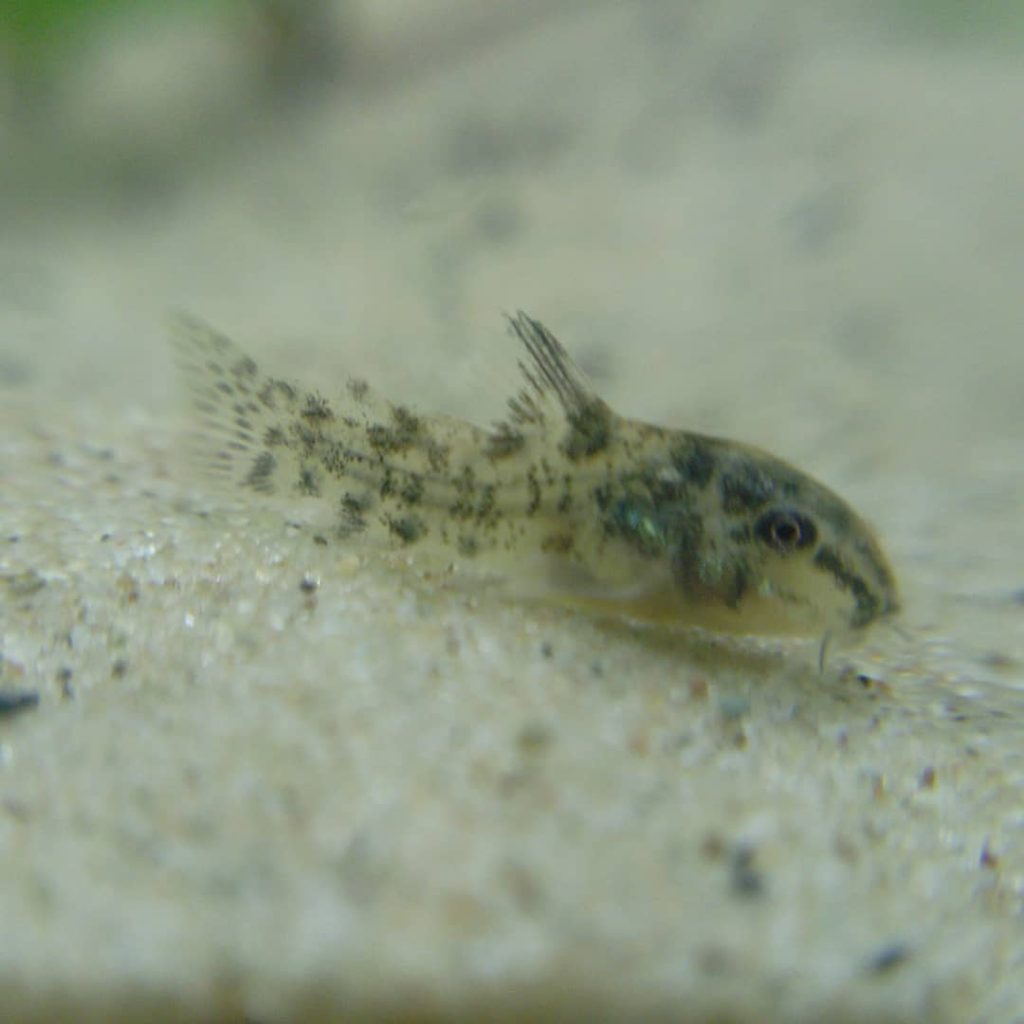
Their bodies are armored with bony plates, adding a unique texture to their appearance. A pair of barbels resides near their mouth, aiding in their tactile navigation across the substrate. When in schools, their synchronized scavenging is a delightful display of natural behavior that can enhance the aesthetics of any freshwater aquarium setup.
| Feature | Description |
|---|---|
| Body Coloration | Silver-grey to greenish |
| Patterns | Black spots and patches |
| Variations | Albino, Bronze |
| Armor | Bony plates |
| Additional Features | Pairs of barbels |
| Schooling | Synchronized movement |
Behavior & Temperament
Peppered Corydoras (Corydoras paleatus), renowned for their pleasant nature, thrive in community aquariums where their harmonious demeanor comes to the fore. They are acclaimed for not being fin nippers and demonstrate no aggression towards other fish; their barbels and fin spines serve as defensive mechanisms rather than tools of hostility. Social and inherently peaceful, these fish enhance their surroundings with a tranquil presence.
They flourish when in the company of others, with a preference for being kept in groups, which provides them with the comfort and stimulation they need for showcasing their naturally schooling instincts. This compatibility, combined with a lifespan of around five years, endears them as a resilient and engaging species ideal for communal aquatic settings.
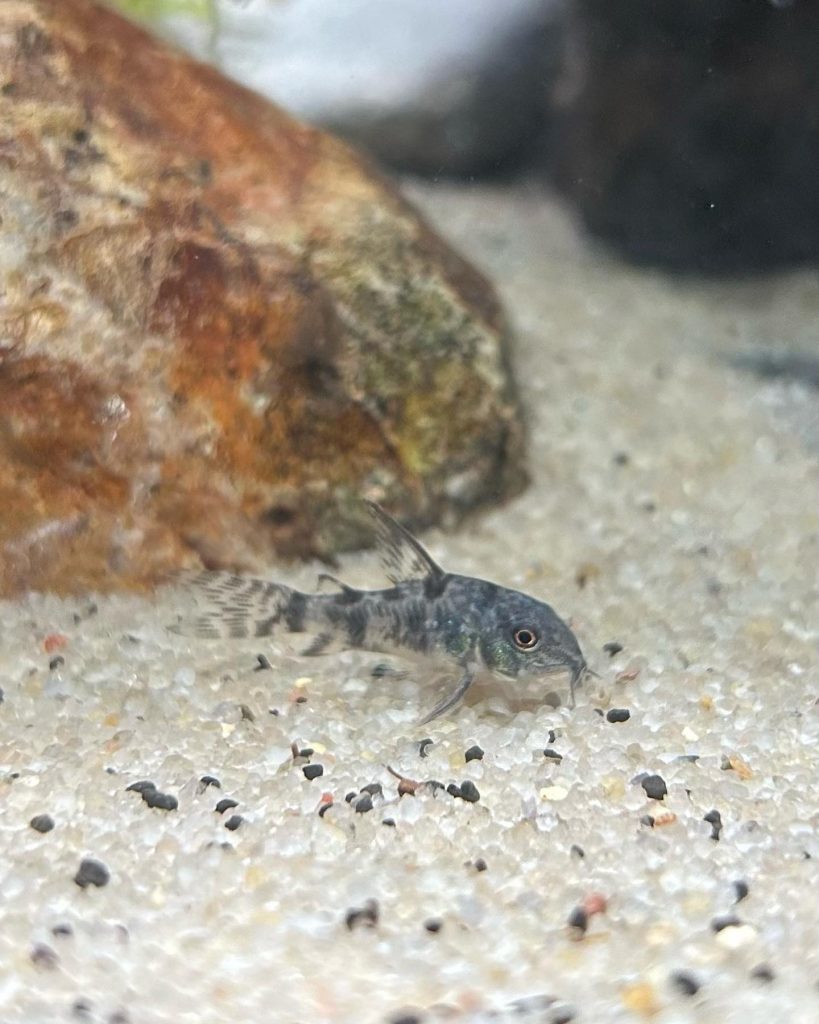
Are Peppered Corydoras Fin Nippers?
Peppered Corydoras are not fin nippers, ensuring they provide a serene underwater environment. Their peaceful temperament makes them suitable companions in diverse community tanks, where their gentle nature allows other species to flourish unbothered.
Are Peppered Corydoras Aggressive To Each Other & Other Fish?
Peppered Corydoras maintain a non-aggressive stance both among themselves and in relation to their tank mates. Their behavior is harmonious rather than antagonistic, ensuring a placid dynamic within the aquarium. They are most content when in the company of other non-aggressive species such as live bearers, danios, and tetras, making them exemplary candidates for peaceful community tanks.
Are Peppered Corydoras Friendly To Each Other & Other Fish?
Indeed, Peppered Corydoras exude friendliness towards each other as well as with other fish. They enjoy social interactions and prefer environments adorned with larger stones, driftwood, and robust plant life, offering ample hiding spaces that contribute to their amiable behavior. Proper conditions, including a temperature range of 64-78.8°F (18-26°C) and moderate water circulation, are vital in upholding their docile nature.
Are Peppered Corydoras Schooling Fish?
Peppered Corydoras are quintessential schooling fish that find comfort in numbers. Kept ideally in schools of six or more, their synchronized scavenging and movement lend a dynamic yet peaceful ambiance to any fish tank. Observing them interact in a group is both engaging and integral to their wellbeing, as it mirrors their natural behavior in the wild.
Can You Have Just One Peppered Corydoras In The Tank?
While a single Peppered Corydoras can survive in an aquarium, it is not recommended as these are inherently social creatures that could experience stress and loneliness when isolated. A solo Corydoras may become less active, exhibit diminished natural behaviors, and be more prone to illness. For the health and vibrancy of the fish, it’s best to keep them in groups.
Do Peppered Corydoras Need To Be In Groups?
To ensure the happiness and health of Peppered Corydoras, keeping them in groups is crucial. A minimum of two is necessary, but a group of six or more is optimal, allowing for natural and comforting schooling behavior. The activity in the tank is also greatly enhanced by their presence, while stress levels are minimized. These catfish are not suitable for company with aggressive species, preferring the congenial company of peaceful community fish.
| Social Aspect | Recommended Group Size | Compatibility |
|---|---|---|
| Schooling & Interaction | 6 or more | Community aquariums |
| Stress Levels & Behavior | At least 2 (ideally 6) | Peaceful fish species |
Food & Diet
Peppered Corydoras exhibit an omnivorous palate, leaning toward a diverse and balanced diet that underpins their health and vitality within the aquarium. Notoriously unfussy, these South American natives will happily accept a smorgasbord of nutrition sources, delighting in both live and prepared foods.
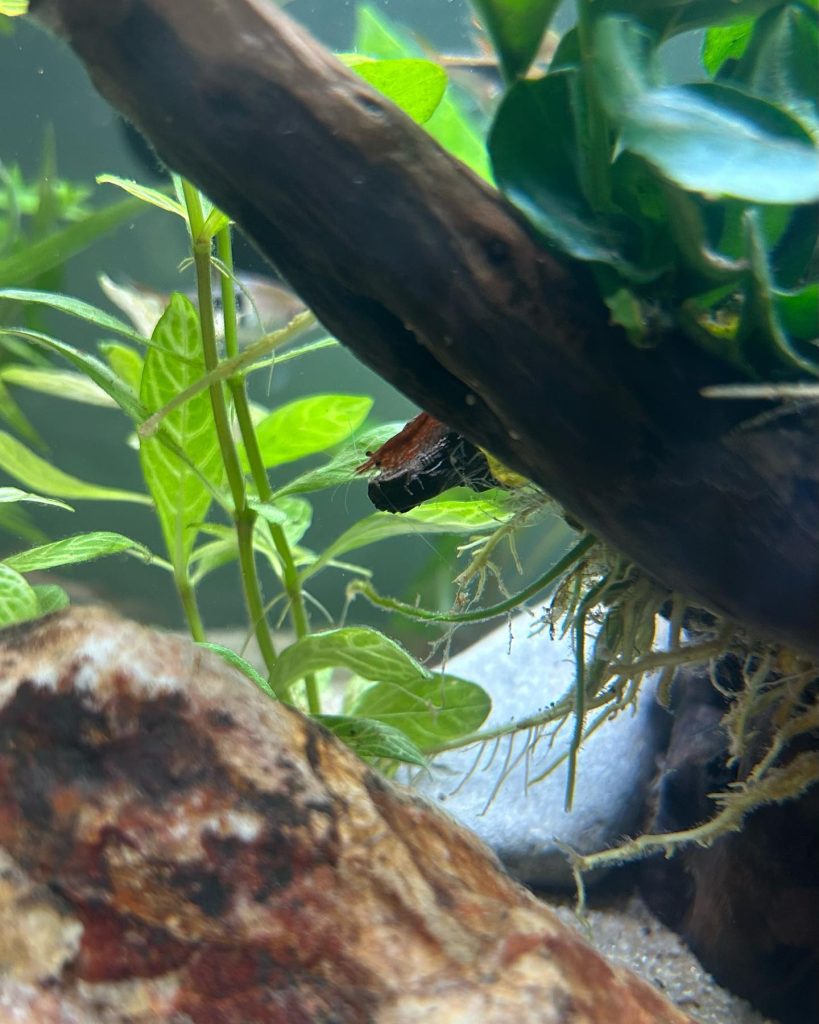
Do Peppered Corydoras Eat Algae?
Yes, Peppered Corydoras will incorporate algae into their diets when available. They are scavengers, meaning algae wafers provide a supplemental source of nutrition similar to their natural foraging habits. While they are not to be considered a primary solution for algae control, providing the occasional algae wafer can contribute to meeting their dietary requirements.
Do Peppered Corydoras Eat Shrimp?
Peppered Corydoras do partake in eating shrimp when given the opportunity. In their natural settings, they would consume small crustaceans; therefore, offering them shrimp, particularly in the form of freeze-dried or baby brine shrimp, can furnish them with familiar and nourishing fare.
Do Peppered Corydoras Eat Bloodworms?
Bloodworms are among the preferred live foods for Peppered Corydoras. These fish are bottom feeders and will zealously consume bloodworms that sink to the substrate. It’s beneficial to provide them with this type of food in moderation, as part of a varied diet that supports their nutritional needs.
Do Peppered Corydoras Eat Mosquito Larvae?
Mosquito larvae can be a natural component of a Peppered Corydoras diet and offering it can enhance their intake of live food. It is imperative, however, to source these larvae from safe, uncontaminated environments to prevent the introduction of diseases or toxins into the aquarium.
Do Peppered Corydoras Eat Planaria?
Although Planaria are not a typical dietary component, Peppered Corydoras may consume them if present in the aquarium. However, as Planaria can be indicative of overfeeding or poor tank maintenance, their appearance should prompt a re-evaluation of the tank’s ecological balance rather than be considered a food source.
Do Peppered Corydoras Eat Plants?
In terms of plant matter, Peppered Corydoras do not actively eat living plants, but will forage on dead plant matter that accumulates on the tank bottom. They are predominantly carnivorous but will ingest plant material incidentally as part of their scavenging behavior.
To ensure the optimum health and longevity of Peppered Corydoras in captivity, it’s advisable to provide them with a nutrient-rich and varied diet that mimics the diversity of their natural food sources. Observing them during feeding times will ensure they are actively partaking and thriving in their environment.
Sexing: Male vs Female
Determining the sex of Peppered Corydoras can be challenging, but there are subtle nuances that can help. Females typically exhibit a more robust build, with larger and rounder bellies, especially when viewed from above. In contrast, males appear smaller and more slender.
During breeding, these differences become more pronounced. Males often boast a notably larger dorsal fin that makes them stand out, along with a more pointed anal fin. In some cases, males might display enhanced coloration as well.
Breeding endeavors can benefit from careful selection of sex ratios. A pair may consist of one male and one female, though breeding trios with two males and one female are common. Some breeders even advocate for a higher male to female ratio to increase the chances of successful spawning.
Observation Tips:
- Look at the fish from above; females will be wider across the body.
- Note the fins; males typically have larger dorsal fins.
- Assess the colors; males may be slightly brighter.
Understanding these differences is vital for hobbyists wishing to breed these peaceful and hardy fish. Through careful observation, sexing Peppered Corydoras can be effectively managed within the tranquil confines of a community fish tank.
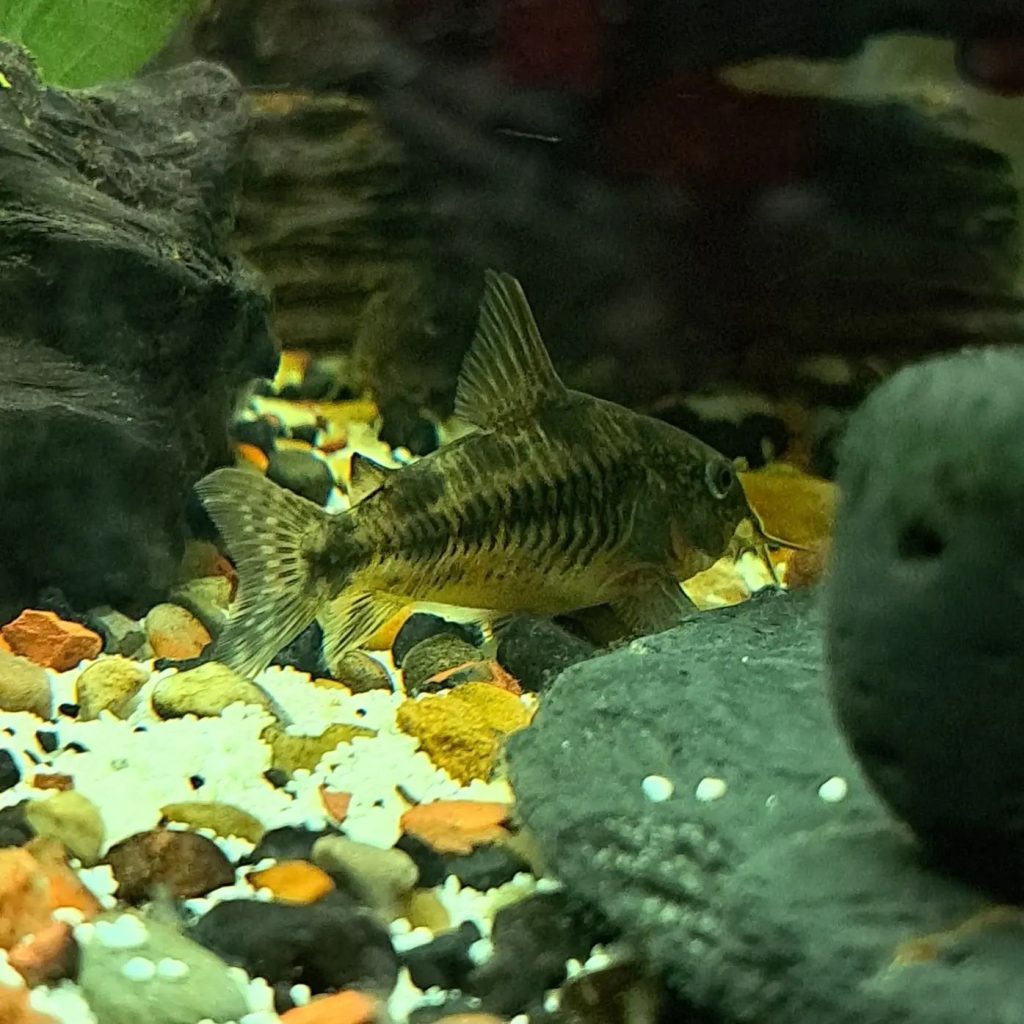
Peppered corydoras Tank Mates
Peppered Corydoras, known as Corydoras Paleatus, are exemplary inhabitants for a peaceful community aquarium. They are inherently non-aggressive, blending seamlessly with gentle fish that share their tranquil nature. Ideal tank mates include live bearers like mollies and guppies, swift swimmers such as danios, and the colorful and energetic tetras. With these companions, Peppered Corydoras create a harmonious underwater society.
Significantly, they are not just peaceful but beneficial, acting as dither fish to coax shyer species into the open, thus enhancing the vibrancy of the fish tank. However, it’s crucial to avoid pairing them with rough fish. Aggressive fish such as cichlids or predatory aquarium crayfish can pose a threat to these docile armored catfish.
For optimum health and social interaction, Peppered Corydoras should be kept in schools. A minimum group of three is necessary, but six or more is preferable. With this schooling dynamic, they exhibit natural behaviors and provide a striking display as they elegantly forage together along the aquarium floor.
Here’s a succinct list of compatible tank mates for Peppered Corydoras:
- Live bearers (Mollies, Guppies)
- Danios
- Tetras
Tank Mate Caution:
- Avoid aggressive fish (Cichlids)
- Do not house with predatory crayfish
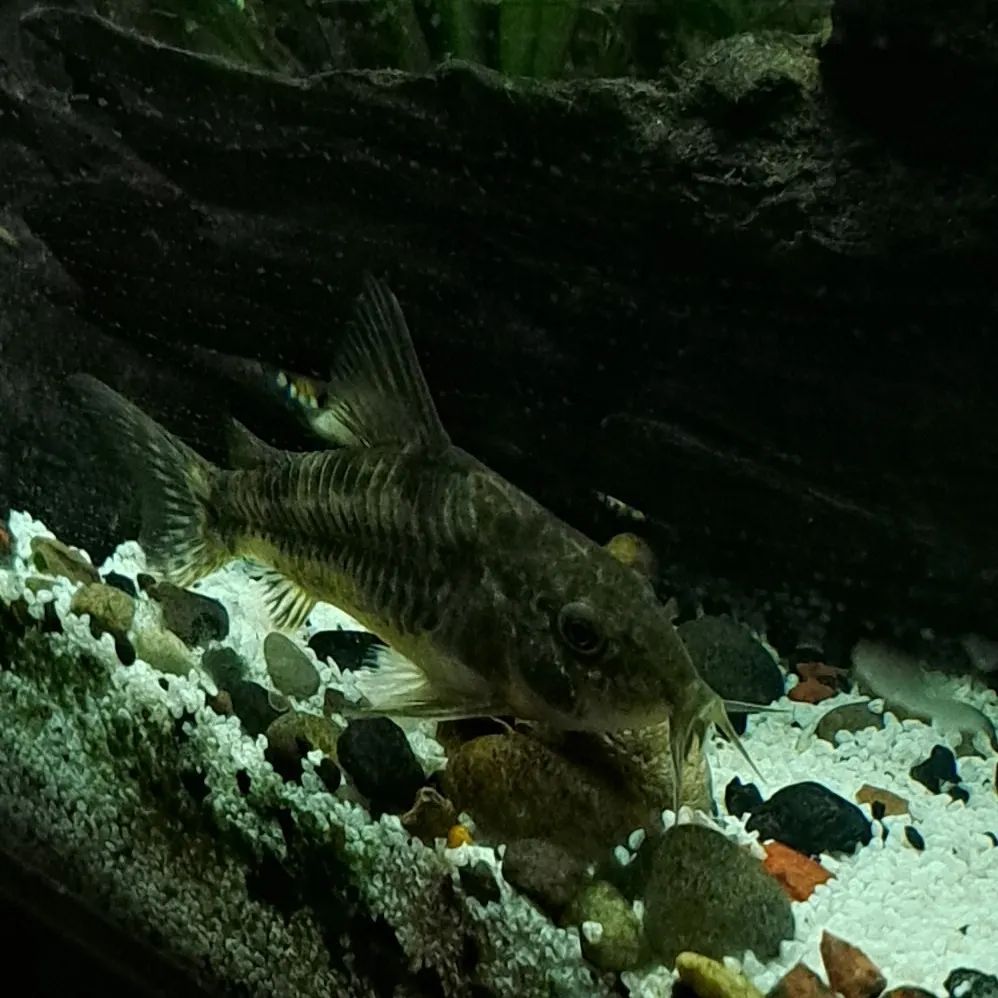
Aquarium Setup
Creating an optimal environment in your aquarium is crucial for the well-being of Peppered Corydoras (Corydoras Paleatus). These freshwater fish thrive in a tank that closely resembles their natural South American habitat. A harmonious mix of the right tank size, water parameters, filtration, and lighting will ensure that your Peppered Corys live in a healthy and stress-free environment.
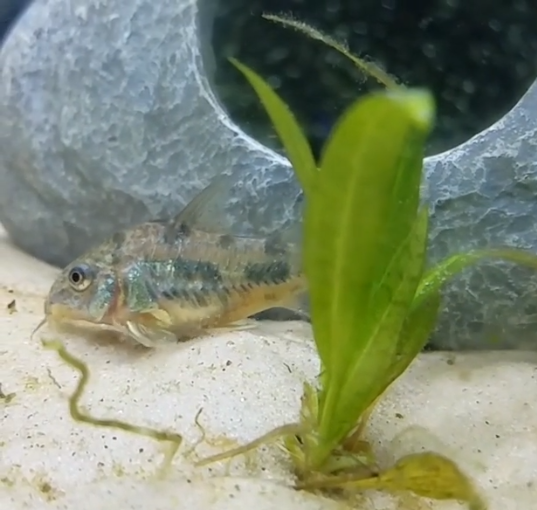
Ideal Tank Size
When deciding on a tank for Peppered Corys, start with a minimum of 10 gallons. However, a 15 to 20-gallon tank is more suitable for a small school. The bottom dimensions of the tank are particularly important, as these fish are bottom dwellers. The larger surface area provides more space for them to explore, which is essential for their overall well-being.
Ideal Water Parameters
The Peppered Cory thrives in a temperature range of 64 – 79 ℉ (18 – 26 ℃), which is typical for many South American freshwater fish. The water should be slightly acidic to neutral, with a pH level around 6.0-7.0, and the water should be soft, with a carbonate hardness (KH) of 3-12. It’s essential to avoid sudden changes in temperature and pH, as these can cause stress to the fish. Regular monitoring and maintenance of water conditions will support the longevity and health of your Corydoras.
Filtration
Peppered Corys need clean, well-oxygenated water to stay healthy. A hang-on-back filter is often recommended, with the AquaClear Power Filter being a popular choice due to its durability and effectiveness. The filtration system should create some water movement at the surface to keep oxygen levels high, but it should not disturb the bottom of the tank where Peppered Corys spend most of their time. Ensure regular filter maintenance to keep the aquatic environment pristine for these peaceful schooling fish.
Lighting
Unlike some other Corydoras that prefer subdued lighting, Peppered Corys adapt well to moderate to normal lighting conditions, reflecting their adaptability in the diverse environments of the aquarium trade. Ensure the lighting in the tank meets these preferences without creating overly bright spots that could stress the fish. Floating plants can be added to diffuse light and create shadowed areas, offering a comfortable habitat that aligns with their desire for occasional hiding spots. Lighting also benefits plant growth within the tank, which in turn supports the ecosystem that Peppered Corys are part of.
Common Possible Diseases & Prevention
To maintain the health of Peppered Corydoras, keeping the nitrate levels in check is vital. Aim for nitrate concentrations below 20 ppm. This can be achieved through regular water changes, which helps prevent the onset of stress and disease common among aquatic pets like the armored catfish.
When it comes to disease treatment for these peaceful community fish, options like pimafix or melafix are safe and effective. However, treatments containing potassium permanganate or copper should be avoided as they can be harmful to Corydoras. If you need to use malachite green or formalin, administer it at a reduced dose—about a quarter to half of the recommended amount due to the Peppered Corys’ sensitivity.
To proactively shield your fish from diseases, ensure a proper tank environment and a balanced diet. This reduces stress, enhancing the fishes’ resilience against illnesses. Moreover, it’s critical to clean or quarantine anything new you introduce to the tank—be it other fish, plants, substrate, or decorations. This step helps in preventing the spread of unwanted bacteria, safeguarding the well-being of your peaceful schooling fish.

Breeding Peppered corydoras In Aquarium
Breeding Peppered Corydoras, or Paleatus Corys, follows a similar pattern to that of other corydoras species. These freshwater fish, native to South America, are known to breed spontaneously when kept in groups, especially in a well-maintained fish tank. However, for those looking to increase breeding success, there are specific steps that can be undertaken.
Firstly, it is recommended to set up a dedicated breeding tank. The ideal environment should mimic their natural habitat, with soft substrate to protect the sensitive barbels of these peaceful schooling fish. Once the breeding tank is prepared, a ratio of two males per female is suggested to encourage breeding behavior. Prior to introducing them to the breeding aquarium, condition your Corydoras Paleatus for a minimum of one week on a diet rich in nutrition, such as live brine shrimp, baby brine shrimp, white worms, or frozen foods.
During the spawning process, males typically exhibit dynamic courting behavior, energetically chasing females until the female indicates her readiness to spawn. Then, the males will release sperm, which the female uses to fertilize her batches of eggs. Observing this natural breeding dance can be a fascinating and rewarding experience for any aquarium enthusiast.
Key Steps for Breeding Peppered Corydoras:
- Set up a specific breeding tank.
- Use a male-to-female ratio of 2:1.
- Condition with a high-quality diet.
- Monitor for courting and spawning behavior.

